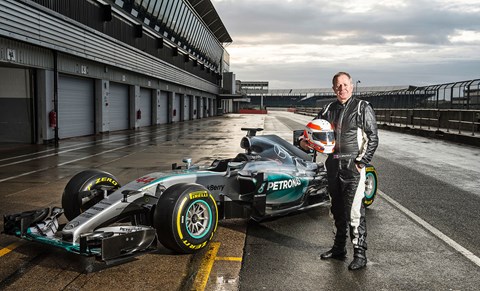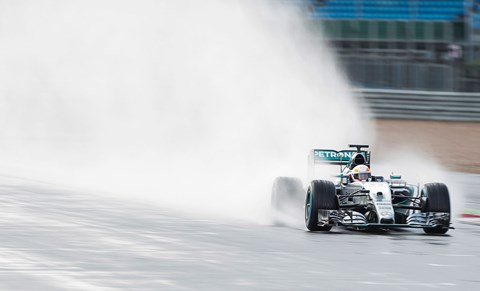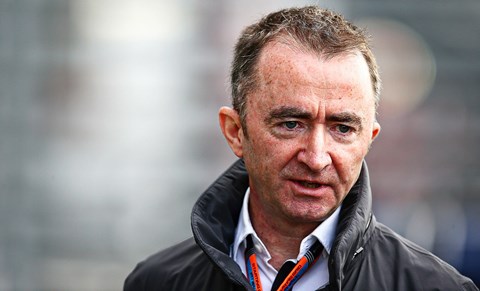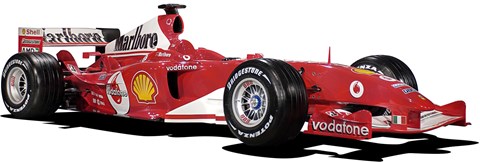► We drive Lewis Hamilton’s F1 car!
► Full review of the 2015 championship-winning W06
► But is it the greatest F1 car of all time?
Think Usain Bolt and Mo Farah combined; for the Mercedes W06 – the car that swept Lewis Hamilton to his third World Championship with four races to spare – was able to replicate the talents of both. It was a hugely impressive sprinter during qualifying, while still able to dominate the long game on Sundays.
The car took 18 poles and 16 wins from 19 races and it hoovered up 85.3% of the available points, up from 81.5% last year. No car in the history of F1 has been more dominant; even McLaren’s MP4-4 of 1988 took ‘only’ 83% of the available points.
Versatility was the key to the W06’s success: a 30bhp advantage over the opposition allowed it to dominate at the power tracks of Monza and Spa; superior levels of traction and mechanical grip won through at Monaco and Melbourne, and unrivalled aerodynamic efficiency gave the car an advantage at Silverstone and Barcelona. There was no weakness. Even Singapore, where it was mysteriously outclassed by Ferrari’s F15-T, would be a different story if we went back to Marina Bay right now.
‘I know I’m incredibly lucky to drive for a team like this,’ said Hamilton. ‘They’ve given me the best car; it’s just so much fun to drive and so fast. I feel blessed to have this opportunity.’
Much has been written about Hamilton’s prodigious talent, which many believe makes him capable of wringing great performances even from an uncompetitive car, but the astonishing late-season resurgence of Hamilton’s team-mate Nico Rosberg suggests something else is happening too. Maybe the W06 is the real star. Has F1 ever seen a car like it?They could have cut corners, ensuring Sky Sports F1 coverage and a story in CAR for minimum disruption to their hectic schedule, and they could have put me in an older iteration of the W06, but that’s not how Mercedes F1 does things.
This would be as good as it gets if your name’s not Lewis or Nico, with a factory visit to try the car for size (tight – today’s drivers are all snake hips and minimal body fat), a fitting for a proper bead-and-resin seat despite my 10-lap allocation and a full technical briefing on the car and its systems. What’s more ‘my’ W06 would be state-of-the-art, with the very latest powerplant. I even had the chance to ask the regular drivers for some tips. Lewis seemed more concerned that I drove Nico’s car and not his…

The weather forecast had consistently predicted rain showers. It was wrong – deluge is closer to the mark as I climb into the car. Earlier, when I arrived at the circuit, a team member was sweeping floodwater from the garage. Everywhere is waterlogged, not least the track. What’s more, I’m told the team needs the chassis for some important rig work the following day – a spot of aquaplaning and a trip into the barriers could mean a bill stretching into hundreds of thousands of pounds, not to mention the loss of the very latest engine, gearbox and aero parts.
With some seatbelt finessing and a move of a few millimetres forward on the heel-rest I feel comfortable and ready to go. How I miss that special feeling of being firmly attached deep into an F1 chassis, as the only part not created on a computer or honed in a wind tunnel. And as we roll out of the pits I feel totally serene – I was expecting the best, and that’s what I experienced.
If the W06 has a defining quality it’s that its hugely complex systems are integrated and honed to the point of subconscious perfection. You know the brake-by-wire system is a web of hydraulics, electronics and regenerative charging but today, even in cold and wet conditions, the end result is nothing more or less than a progressive, predictable, perfect response.
It’s the same story with the engine. Batteries and 1.6-litre turbo V6 come together to deliver seamless, instant and driveable power. Turn-in is good, traction remarkable – at one point the back wildly steps out through Copse but it’s raining hard again now, and the corner looks like a lake. The gearbox? So good you don’t notice it.
What you can’t fail to notice is the intense, relentless acceleration. I raced turbos in the 1980s running 1250bhp on qualifying boost, but we had manual gearboxes and the engines switched from lag to insane, wheel-spinning power in a heartbeat. Then they’d start to overheat and lose power. The Mercedes power unit delivers a combined 900bhp of turbine-like thrust – always pushing as you go through eight seamless-shift gears. It’s totally, utterly, addictive. I have no idea why today’s drivers moan: the previous 2.4 V8s were torque-less screamers that couldn’t pull the skin off a rice pudding. With their wall of grunt the current cars are much harder to drive when it comes to power application, but even in streaming wet conditions the Mercedes is always communicating: ‘All fine, what do you want from me next?’

A great racing car is about consistently good aero performance, instinctive controls and strong, linear power. It’s not about peaks of anything – when a driver knows and trusts the car underneath him then his confidence and speed grows. The W06 is so together in every respect you start thinking perhaps the driver doesn’t matter. Then you remember the strength of the competition, and that even the greatest cars still need the finest drivers at the wheel, constantly exploring the limits to win races and championships. Work on this year’s W06 began way before the current regulations had even been introduced. Mercedes were still following in the wheeltracks of Sebastian Vettel’s all-conquering Red Bull when the initial layout of the car was penned in the summer of 2013, and work on the 2015-spec power unit was already in full flow by then.
Both car and engine were evolutions of their predecessors, but both were also significant steps forward.
‘The learning process is always very steep in the first year of a new set of regulations,’ says Mercedes tech boss Paddy Lowe. ‘You run out of time, not ideas, so year two usually sees a lot of progress as well, and we knew where we needed to improve.’
The results were immediate: Nico Rosberg completed 157 laps on day one of winter testing at Jerez, more than double the mileage of any other car present. ‘Reliability was a weak point for us last year,’ says Lowe, ‘so a lot of work was done to improve that. The new nose regulations were a big topic for our aero programme as well and the guys at Brixworth did a great job with the power unit.’
The goal was to make the PU109B Hybrid more thermally efficient in an effort to produce greater absolute power. And boy did they manage that: in Q3 qualifying spec, the engine immediately produced 50bhp more than last year, while also accommodating the reliability fixes needed for greater mileage after the number of power units for the season was reduced from five to four.
There were very few carry-over parts from 2014-15 on both chassis and engine. The motor featured new variable inlet trumpets and a new exhaust concept, and development didn’t stop when the season got underway. The early introduction of the 2016-spec power unit, known as Phase 4, added another 25bhp to the total, while also being more fuel efficient. All of which makes the latest motor the most powerful Mercedes F1 engine ever; it has more grunt than the 3.0-litre V10s of the mid-’90s, when qualifying engines and exotic metals were de rigueur.

‘It’s so difficult to win world championships,’ continues Lowe, ‘and to win two in a row is fantastic. If there’s one area where this car has improved on last year, it’s in terms of reliability. We’re proud of the strides we made there.’
How does Lowe, who worked for both Williams and McLaren in their heyday, rate this year’s Mercedes? ‘I suppose it has to be one of the best in the history of the sport.’
‘It’s a racingdriver’s dream’
Nico: ‘It’s a racing driver’s dream of getting an opportunity to drive a car this good, so I know I’m in a very lucky position. It’s just so fast, and it doesn’t matter what track or what conditions you throw at it; you know at the start of the weekend that you have a chance to take pole position and win the race. That’s a fantastic position to be in.’
Lewis: ‘I knew from my first lap in the car that it was good. The balance was immediately there and when we made set-up changes it reacted in a predictable way. It was clear from testing that my main rival for the championship was going to be Nico because I doubted that anyone else would have come up with a car this good.’
Out of sight! How W06 blew F1 away in 2015
10 – number of consecutive races with 2 cars on the podium (a record)
85.3%– percentage of maximum possible points won in a season (a record)
16 – number of race wins out of 19
15 – number of front-row lockouts (a record
Seven – number of consecutive poles by one driver in a season (Hamilton – only Senna in ’89 has more)
81%– percentage of available laps led
12 – number of 1-2 finishes
33 – number of front-row grid positions (a record)
18 – number of pole positions
Nine – number of races led from start to finish
W06: toe-to-toe with the greatest of all time

5) Lotus 72
Coming from the pen of legendary designer Colin Chapman, this car redefined the use of aerodynamics in the early ’70s. ’It was the best racing car I ever drove,’ said Emerson Fittipaldi, who won the title in it in 1972.

4) Williams FW15
The most sophisticated car in F1 history? Quite probably, at least until the current regulations were introduced in 2014. The FW15 had active suspension, ABS and four-wheel steer, and it dominated in the hands of Alain Prost in 1993.

3) McLaren MP4-4
‘We make history; you write about it.’ Ron Dennis was the definition of modesty when he uttered this immortal line in mid-’88, but he wasn’t wrong. In the hands of Senna and Prost the MP4-4 was in the throes of winning 15 out of 16 races.

2) Mercedes W06
Utterly dominant in an era of the highest tech and complexity. W06 has scored 23 consecutive poles, and given Lewis not only two titles but 16 consecutive podiums and 20 consecutive front-row starts. Don’t expect it to let up in 2016 either…

1) Ferrari F2002
There wasn’t a championship showdown in 2002. Far from it in fact. So dominant was this car that Michael Schumacher clinched his fifth world title at the French Grand Prix in July. Quite frankly, what were the others doing?